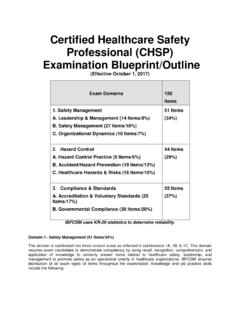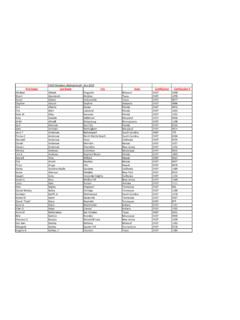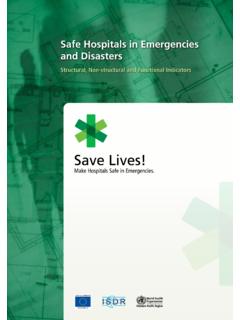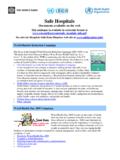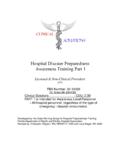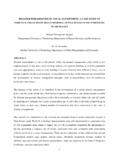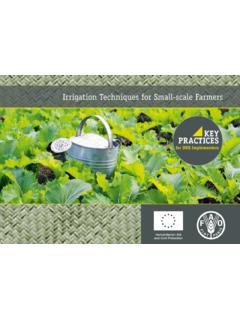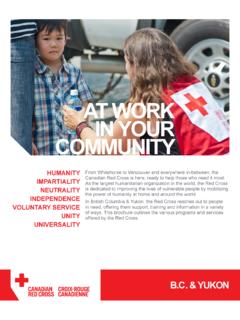Transcription of Certified Healthcare Emergency Professional (CHEP ...
1 Certified Healthcare Emergency Professional ( chep ) examination blueprint /Outline (Effective October 1, 2017) Exam Domains 145 Items 1. Emergency Management A. Healthcare Emergency Principles (30 Items/21%) B. Emergency Preparedness Concepts (26 Items or 18%) 56 Items/39% 2. National Disaster Preparedness A. National Response Framework (26 Items/18%) B. Disasters, Terrorism, & Resilience (25 Items/17%Items) 51 Items/35% 3. Safety & Environmental Standards A. Safety/OSHA Requirements (20 Items/14%) B. Consensus & Voluntary Standards (18 Items/12%) 38 Items/26% IBFCSM uses KR-20 statistics to determine reliability.
2 Job Task & Practice Competencies o Collaborate with response entities, mutual aid partners, coalitions, and all stakeholders o Understand the activities that could impact preventing and responding to Emergency incidents o Develop, coordinate, or implement plans used to respond and recover from all hazards o Ensure alteration of Emergency procedures based on regulatory or technologically changes o Maintain/update all resource materials associated with Emergency preparedness plans o Coordinate disaster response or crisis management activities as needed to meet special needs o Maintain liaisons to ensure plan development, coordination, and resource allocation/exchanges o Know federal, state.
3 And local regulations and policies affecting Emergency planning o Prepare Emergency situational/status reports that describe response and recovery efforts o Design, administer, or coordinate Emergency preparedness training, education, or orientation of o Coordinate with agencies, hospitals, and other institutions as needed to determine capabilities o Evaluate Emergency management plans in accordance with state and federal regulations o Develop Professional working relationships with other Emergency management personnel o Collaborate with officials to conduct damage assessments following disasters or emergencies o Conduct hazard vulnerability surveys to determine Emergency related risks and hazards Domain 1 Healthcare Emergency Concepts (56 Items/39%)
4 This domain requires exam candidates to demonstrate competency by using recall and recognition, comprehension, and application of knowledge to correctly answer items related to Healthcare Emergency management and disaster preparedness to ensure Healthcare organizational viability. Exam items are distributed throughout the examination . Knowledge and job skills include the following: a. Design, implement, and maintain comprehensive management systems by defining Emergency preparedness requirements including the development of policies, procedures, and plans needed to protect patients, staff, visitors, and property.
5 B. Implement policies, procedures, and directives in systematic manner to support requirement to provide medical care as needed during declared emergencies or disaster events. c. Determine the effectiveness of Emergency related functions and relevant systems using collaboration, communication, and coordination to ensure continuous medical operations. d. Apply sound management and leadership concepts to efficiently to improve all Emergency and disaster preparedness functions. e. Use appropriate methods that will ensure stake-holders understand their roles in formulation, coordination, and implementation of Emergency preparedness actions.
6 F. Present and coordinate information with response organizations, government agencies, incident command structures, management, contractors, vendors, and the public about Emergency management requirements. g. Accept responsibility to promote Emergency management by providing advice on issues related to Emergency actions necessary to provide services and protect people and property. h. Domain 1 sample exam topics: o All-hazards preparedness o ASPR capabilities o Bioterrorism preparedness o Capabilities o CMS requirements o ICS principles o Communications o Community involvement o Resource management o Incident action planning o Federal agency responsibilities o Disaster legislations o Drills and exercises o Stakeholders o ESF#6 o ESF #8 o ESF#9 o ESF #13 o FEMA capabilities o FEMA responsibilities o Building egress o Preparedness o Management functions o Coalitions o HVA/EOP o Recovery capabilities o Response capabilities o Healthcare sector preparedness o Exercise programs o Hospital response o
7 Evacuation planning o Community emergencies o Incident Command Systems o Incident commander responsibilities o Information management o Accreditation standards o Management principles o Managing incidents o Organizational structure/culture o Multi-agency coordination o NIMS and Healthcare o Organizational fundamentals o Pandemic and other surge events o Planning priorities o Preparedness training o Policy directives o Strategic planning o System methods o Command structure Domain 1A Healthcare Emergency Principles (30 Items/21%) 1. Chemical exposure incidents 2. Coalitions 3. Disaster planning 4.
8 Disaster response 5. Emergency drills 6. Disaster exercises 7. Emergency communication 8. Emergency management planning 9. Emergency management priorities 10. Emergency operations 11. Emergency planning capabilities 12. Emergency planning priorities 13. Emergency planning resources 14. Technology Emergency priorities 15. Emergency support functions 16. Facility risks 17. Federal agency oversight 18. Hazard and risk identification 19. Hazard evaluation and assessment 20. Incident command structure 21. Mitigation planning 22. National incident management system 23. Natural disasters 24.
9 Patient issues 25. Planning and analysis 26. Planning coordination 27. Preparedness actions 28. Prioritized response 29. Security 30. Surge planning Domain 1B -- Emergency Preparedness Concepts (26 Items/18%) 1. Assessing situations and decision making 2. Communication and information processes 3. Evaluating disaster impact 4. Coalition drills & exercises 5. Fire drills and exercises 6. Casualty drills and exercises 7. Disaster exercises 8. Emergency management priorities 9. Emergency response planning 10. Emergency mitigation planning 11. Emergency standards 12.
10 Evaluating hazards 13. Federal Emergency planning 14. ICS coordination 15. Incident command structure 16. Incident command duties 17. Incident command effectiveness 18. Incident command responsibilities 19. Incident action planning 20. Communication restoration 21. Medical planning 22. National incident command system 23. National preparedness framework 24. Organizational structure 25. Disaster preparedness concepts 26. System methods Domain 2 National Response & Disaster Preparedness (51 Items/35%) This domain requires exam candidates to demonstrate competency by using recall and recognition, comprehension, and application of knowledge to correctly answer items related to Healthcare Emergency management to prevent harm, reduce risks, and maintain a safe environment for staff, patients, and visitors.
